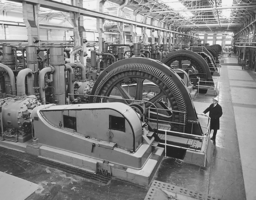 | Back to e-WV
| Back to e-WV
 The West Virginia Encyclopedia
The West Virginia Encyclopedia
 | Back to e-WV
| Back to e-WV
 The West Virginia Encyclopedia
The West Virginia Encyclopedia

Nylon, invented in 1935 in a DuPont laboratory in Delaware, was brought into commercial production through intermediate materials supplied by the company’s Kanawha Valley plant. Nylon was the first of a new family of wholly synthetic textile fibers, and although the name describes a generic class of polymers it has also become a synonym for ladies’ stockings, its first commercial application. Today, a tenth of the world’s textile and carpet fibers are made from nylon. It is also widely used as an engineering plastic in automobiles, machinery, and appliances.
The ‘‘nylon 66’’ polymer, so-called because each of the two reacting chemicals, hexamethylene diamine and adipic acid, has six carbon atoms, was patented in September 1938. By that time, work had already begun on producing the necessary chemicals in commercial quantities at the DuPont Belle Works, near Charleston. The Belle Works had benzene and hydrogen, the two starting chemicals required to make the nylon 66 intermediates, both products of the coke-making process. The coke was produced at the Belle site from West Virginia coal. From 1937 until 1939, four pilot plants were built at Belle to develop the technology for producing hexamethylene diamine and adipic acid starting with benzene and hydrogen.
The diamine and the adipic acid were combined to form the raw polymer called ‘‘nylon salt.’’ The nylon salt was shipped to the Seaford, Delaware, DuPont plant where it was forced through a die plate containing very small holes to form nylon fibers. The fibers were then sent to textile mills to be woven into products such as hosiery, parachutes, and rope.
The first nylon fiber was produced at Seaford on December 15, 1939. By 1941, a second spinning plant had been built at Martinsville, Virginia. Most of the early production was used by the government during World War II for materials critical to the war effort, such as parachutes (where it replaced silk) and cord for B-29 bomber tires. However in 1940, DuPont put four million pairs of stockings on sale nationally. The ‘‘nylons’’ sold out in four days.
From 1937 until 1946, every pair of nylon stockings, every nylon parachute in World War II, and every nylon-bristle brush came from Belle Works nylon salt, made from West Virginia water, and coal. Nylon salt continued to be produced at the Belle Works until 1968, although many other plants were built around the world after 1946 to meet the growing demand.
Written by Charles J. Denham
Sentimental Journey: The DuPont Belle Works: A 75-Year History 1926-2001. Charleston: E. I. du Pont de Nemours & Co., 2001.
McAllister, John F. The First Nylon Plant. Washington: American Chemical Society, 1995.